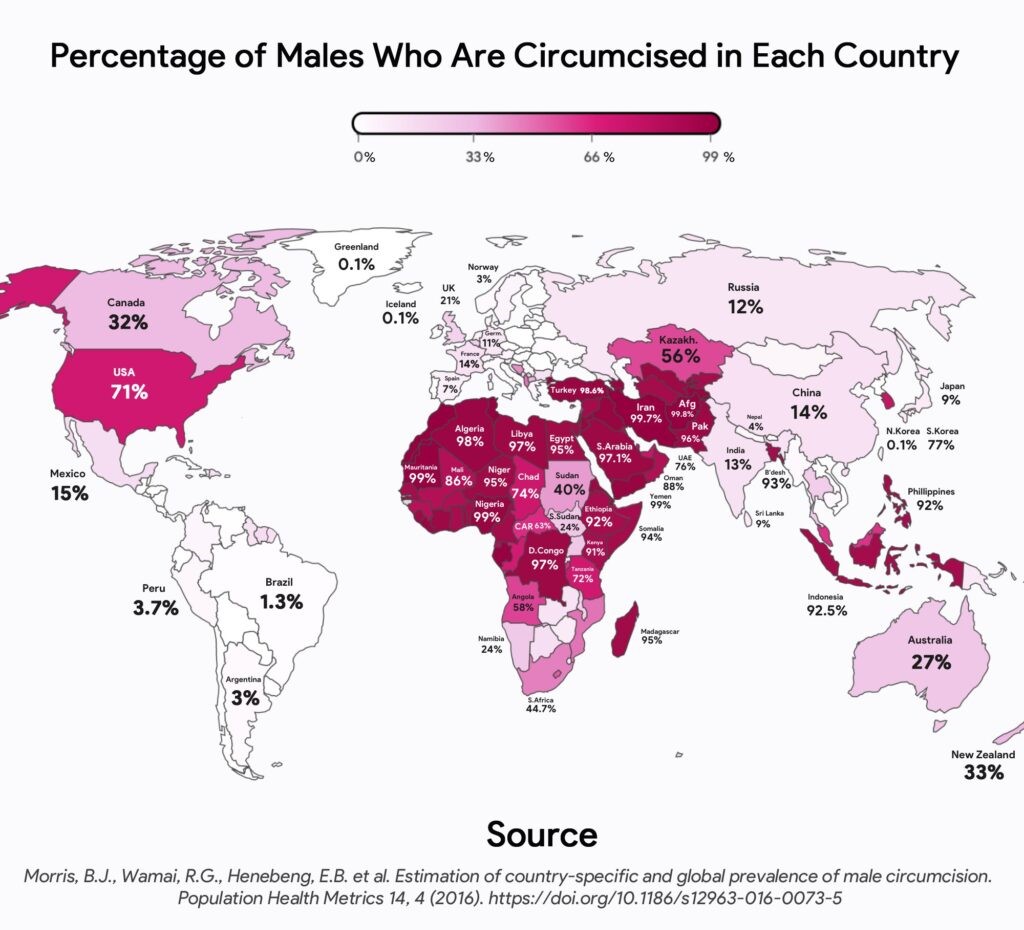Male Genital Mutilation
How could male infant genital mutilation (euphemistically called “circumcision”) have become such an established ritual? It defies all logic and reason. It comprises non-therapeutic (viz. not medically required) surgery, without consent, to permanently and irreversibly alter an individual’s genitals. Just as we call sex without consent ‘rape’, infant circumcision without consent or reasonable justification must be called out as ‘mutilation’.
Alan Cumming, the well known Scottish actor, singer, writer, and activist, has taken a very clear stand on it. And the late polemicist Christopher Hitchens very eloquently sought to raise awareness and break the taboo around discussing genital mutilation.
This very accessible video gives an introduction to the misinformation surrounding “circumcision”. The most comprehensive video on the subject of male genital mutilation is the award-winning video Whose Body, Whose Rights?
Westerners look askance at the ritual body mutilations performed by faraway tribes, but they consider their own ritual mutilations as medically justified. Circumcision Exposed: Rethinking a Medical and Cultural Tradition explores why the United States is the only country in the world to circumcise a majority of its baby boys for supposedly medical reasons.
What is the foreskin?
The foreskin is a highly specialized tissue that is comparable to an eyelid (foreskins are actually used in eyelid replacement surgery). The foreskin (or prepuce) comprises up to 50% (sometimes more) of the mobile skin system of the penis. If unfolded and spread out the average adult foreskin would measure about 15 square inches (90 cm2). This highly specialised tissue normally covers the glans and protects it from abrasion, drying, callusing (keratinization), and contaminants of all kinds. It comprises a delicate belt of densely innervated, sexually responsive tissue responsible for the fullness and intensity of sexual response, and is equivalent to the clitoral hood.
What is done in infant “circumcision”?
Removal of the penile foreskin is gruesome and excruciatingly painful. It involves multiple tissue-damaging steps, including tearing, crushing, and slicing of a highly sensitive part of the body of a healthy baby – often without anesthesia – while the baby is restrained on a board. It is not minor surgery. It is no accident that circumcision is always performed behind closed doors, the parents not being permitted to watch.
Babies can and do bleed to death during the procedure. Around 230 baby boys die each year in the U.S. as a result of circumcision surgery, and this may well be an underestimate given the remorse parents understandably have in acknowledging these deaths. Circumcision removes critical components of male sexual anatomy, which are listed here.
After “circumcision” the head of the penis (glans) is no longer protected by the foreskin, scarring is evident and keratinization sets in. The skin on the glans changes from shiny, smooth and moist to callused and dry. Imagine what would happen to an eyeball if the eyelid was amputated.
Myths and facts about “circumcision”
See here and here and here and here and here.
Where is it done?
There is a high rate of circumcision in Jewish and Muslim populations, and circumcision is quite common in the United States. (Present day routine circumcision in South Korea, and to a lesser extent in the Philippines, has its roots in U.S. influence). Areas of Africa, Australian aborigines, and people of the Near East also practice ritual circumcision. In contrast, routine circumcision is rarely performed in Europe, China, the Far East, and Central and South America.

Why is it done?
Religious
For the ancient Jews it was a loyalty oath, a political deal. Both Judaism and Islam see circumcision as a way to distinguish themselves from non-believers or infidels, respectively.
Socio-cultural
The socio-cultural tradition for “circumcision” is generally perceived as a rite of passage into manhood. Some recent studies associate circumcision with the patriarchal society, where erection is considered a significant sign of male adulthood. Exposure of the head of the penis by circumcision gives it a perpetual appearance of erection, although this is less convincing when the penis is in its usual flaccid state.
Medical
So divorced from its original purpose (to stop masturbation), circumcision became a treatment in search of a disease, and a long list of purported benefits has been developed by the medical profession ever since. But it has not cured mental illness, neurotic behavior, adolescent rebellion, epilepsy, warts, or frigidity. It does not prevent penile or cervical cancer, urinary tract infections, sexually transmitted diseases or HIV/AIDS.
Parents are becoming more aware of the negative consequences of circumcision. This has contributed to the rapid decline of infant circumcision in America. The US government reported that the intact rate for 1993 had climbed to more than 40%, and the CDC reports that 68% of baby boys born in the United States in 2009 remained intact.
This video discusses the history of circumcision and the medical myths surrounding it.
Ethical

The first argument is based on the child’s rights to physical integrity and self-determination. The act of performing an unnecessary amputation violates these rights.
Circumcision violates the Hippocratic oath – “first, do no harm” – since it is an unnecessary surgery that causes injury to an otherwise healthy child, introduces the risk of surgical complications, and has no medical benefits.
All human beings have equal rights. Individuals should not experience discrimination in health care on the basis of sex, race, religion, etc. Since any unnecessary surgical alteration to female genitals has been condemned by the U.N. and has been illegal in the U.S. since 1997, equal rights dictates that male and intersex children have the right to equal protection from unnecessary genital surgeries.
Further, to be ethically and legally defensible, any elective surgery requires informed consent. In infant circumcision informed consent is violated.
Conclusions
There is a conspiracy of silence around circumcision. Men who have been circumcised don’t want to admit that there might be anything wrong with them. They don’t speak about it because they don’t want to think about it. The denial is so deep that it’s not even remotely on their radar. There are several ways for them to deal with the issue but the safest way, psychologically speaking, is to believe at all costs that the surgery performed on them was an enhancement and is preferred by women. This belief is essential to their sexual self-image. They repress the trauma as a defense mechanism in order not to feel the pain and humiliation, which otherwise can even lead to suicide. MGM takes place at a very early age before the child has developed spoken language. Males who are not able to express their painful circumcision memories in words may express them in non-verbal ways such as insensitivity towards others or unexplainable rage.
Circumcision and the commerce of the foreskin constitutes a lucrative industry in the United States. Despite this, some doctors have become opponents of circumcision.
Deliberately inflicting injury on a baby in order to enforce their conformity with a religion, or to satisfy their parents’ views on what a penis should look like, has no place in a modern society. Infant circumcision – regardless of gender – should be stopped.
Language is important. Don’t say a man is uncircumcised. “Uncircumcised” tends to suggest an abnormality, whereas the condition is whole, natural and normal. He is intact! Circumcision is the abnormal state. Women are not called ‘unclitoridectomized.’
There are no compelling medical reasons for amputation of the penile foreskin. Amputating the foreskin deprives the infant of a protective and sexually functional part of his body. Neonatal circumcision is a violation of a new-born male’s right to a whole (intact) body. Nature knows best – how can chopping off a section of healthy tissue improve nature’s evolved design?
What century are we living in? We used to condone slavery, the ducking stool for perceived witches, bear-baiting, all sorts of wierd stuff, but now understand that some things are not worthy of us.

Indeed! You have exposed the dirty secrets behind this money-making farce. Kudos!!
Yes, this really lifts the lid on a very objectionable procedure. Shame on the medics in the U.S.A.! Shame on the apologists who try to support it with bieased, self-serving “research”. and shame on those who would try to foist it on other countries as “normal”. Just proves that the U.S. is totally f***ed up …
Bravo, sir! You clearly showed how totally ridiculous it is. The medical establishment in the United States should be ashamed of themselves for propagating such a vile operation. It is time for the world to criminalize it.